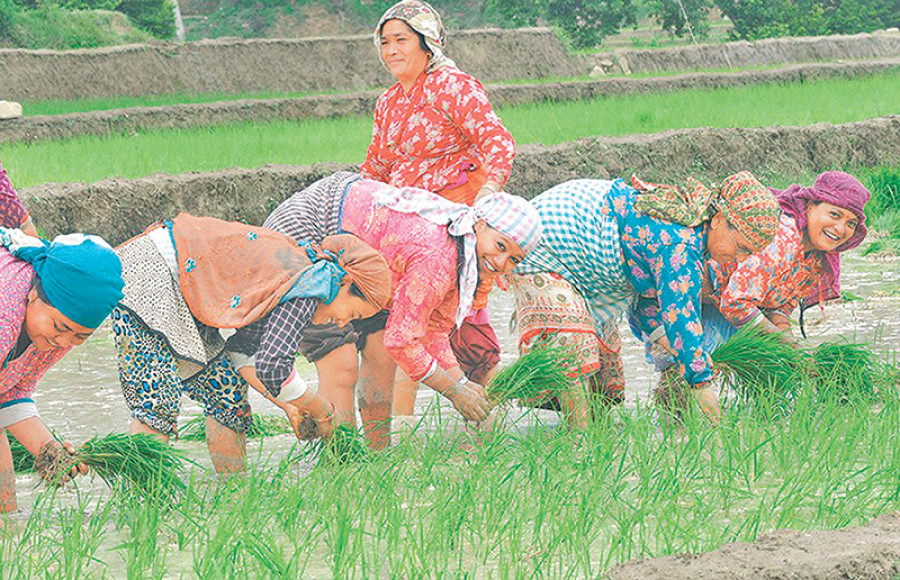Opinion
Focus on farming
The evolution of agriculture in any country is gauged by its average farm size. As agriculture adopts new technologies and innovations, it gradually rises up in scale and subsequently production.
Aadesh Subedi
The evolution of agriculture in any country is gauged by its average farm size. As agriculture adopts new technologies and innovations, it gradually rises up in scale and subsequently production. Ironically, Nepal, an agrarian economy with agriculture accounting for 60 percent of its Gross Domestic Product (GDP), is still stuck in small-scale farming. There are more than 13.8 million smallholder farmers working on an average farm size of 1.4 hectares. Though large-scale commercial agriculture is an important need for Nepal to ensure sustained economic growth and food security, we cannot leapfrog into it instantly without addressing the needs of smallholder farmers. Therefore, we need to make proper interventions and develop incentives to address the problems faced by smallholder farmers who are most vulnerable to climatic and economic shocks.
Market access is the major problem for smallholder farmers in Nepal. As they live in physically vulnerable areas like floodplains and hills that are barely connected by transportation facilities, poor marketing of field produce has been a major limiting factor. As a result, large amounts of agro products end up as animal feed while shortages exist in the market. Public investment in infrastructure must be directed at developing infrastructure that can aid in extending the reach of the supply chain to these farmers.
Proper market access alone cannot help smallholder farmers to get reasonable prices for their produce. Post-harvest mechanisation and proper processing and storage technology are also key factors. According to a recent study by the Food and Agriculture Organisation of the United Nations (FAO), only 5 percent of the total food loss occurs at the consumer level, the rest is lost at different preceding levels of the value chain — post-harvest, processing, storage and marketing.
For example, 30-50 percent of the rice crop loss is caused by the traditional way of threshing using cows. This can be minimised substantially by using mobile threshers.
Mould it right
With most of Nepal’s male population migrating abroad to work, women are left to work the farms. Therefore, in order to develop small-scale farming more effectively, research and development must be focused on female smallholder farmers. Technologies and inputs should be in line with the requirement of women. For instance, light, small and efficient machinery may be in order. Similarly, women may go for qualitative, aromatic and tasty seed grains than those having a higher yield. Such needs of female farmers should be prioritised by the government while formulating policies and plans.
Women should also be given proper training and education to make them familiar with the use and benefit of technology. Though the Nepal government has stationed extension workers in rural areas to provide primary education and training to farmers, the quality of instruction is not so good due to lack of proper audio-visual aids, printed matter and materials. A high prevalence of illiteracy among smallholder farmers makes it difficult for extension workers to provide knowledge through books or other printed materials. To help farmers adopt and learn new technologies, approaches like farmer-to-farmer training, use of audio-visual aids and meetings and discussions can be crucial.
New instruments for productivity
Climate change is among the problems plaguing Nepali smallholder farmers. Without climate change resilient farm practices and technology, their future looks gloomy. Degradation of natural resources like soil, water and biodiversity will potentially increase the vulnerability of smallholder farmers. However, different forms of agro ecological approaches can address these challenges by reducing the environmental footprint of agriculture while also increasing the efficacy of production. Approaches such as organic agriculture, agro forestry, permaculture and conservation agriculture will not only enhance the green economy but also promote diversification that can help smallholder farmers withstand extreme climatic events and price volatility.
Crop insurance can be another way to get through climatic shocks like drought and flood. The government has been offering insurance schemes to farmers since 2013. However, due to institutional, financial and technical barriers, only a few farmers have access to these schemes. Insurance companies have few branches in rural areas which makes it difficult for smallholder farmers to become familiar with insurance. To get around these barriers, the government should work together with rural cooperatives and banks to help smallholder farmers understand the benefits of insurance.
Every developed country has passed through a series of steps to be where it is today. In the beginning, there is development of agriculture. This is followed by industry which is gradually converted into a service-oriented economy until the country become developed and prosperous. Nepal, unfortunately, hasn’t been able to pass beyond the first step: agriculture development. So industrialisation and a service-oriented economy are a long way away. For this reason, the government must address agriculture, and more importantly, the needs of smallholder farmers, to raise the Nepali economy to a higher level. The government should focus on developing a conducive environment for smallholder farmers to enhance their status and upgrade subsistence and small-scale agriculture to commercial and industrial agriculture. This will create a happy, healthy and well fed Nepal.
- Subedi is pursuing a BSc in Agriculture from the Agriculture and Forestry University, Chitwan




 7.12°C Kathmandu
7.12°C Kathmandu










